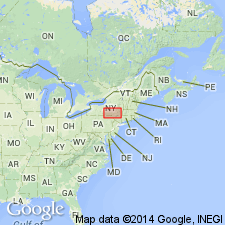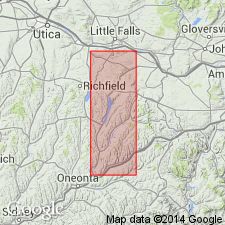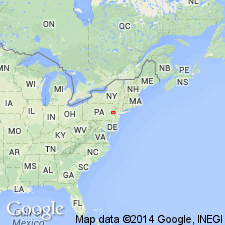
- Usage in publication:
-
- Ravena limestone member
- Modifications:
-
- Original reference
- Dominant lithology:
-
- Limestone
- AAPG geologic province:
-
- Appalachian basin
Summary:
Pg. 65-68. Name proposed for that part of Coeymans formation present at and east of Cherry Valley. Thickness 20 feet at type locality where it overlies Thacher limestone and underlies cherty Kalkberg. To west of type section consists of very hard, coarse-grained gray or blue crystalline limestones. South of type section at Ravena, across Catskill quadrangle, the Ravena is 10 to 15 feet thick. Southwest of Kingston thickens to 15 to 20 feet in Rosendale quadrangle. Much of overlying Kalkberg was included in the Coeymans (Ravena) at Trilobite Mountain by Shimer (1905, New York State Mus. Bull., no. 80). Writer [Rickard] believes that west of type section Ravena thickens to its maximum of 100 feet at Cherry Valley.
Type section: abandoned limestone quarry just south of hairpin turn in road ascending escarpment 0.5 mi northeast of village of Ravena, just west of Coeymans in Coxsackie quadrangle, east-central NY.
Source: US geologic names lexicon (USGS Bull. 1350, p. 617-618).

- Usage in publication:
-
- Ravena limestone member
- Modifications:
-
- Areal extent
- AAPG geologic province:
-
- Appalachian basin
Summary:
Pg. 42-45. Three stratigraphic names are necessary to identify various portions of Coeymans Limestone in Richfield Springs quadrangle. Name Ravena (Rickard, 1962, New York State Mus. Bull., no. 386) has been suggested for undivided Coeymens of eastern New York. Part of Coeymans which grades westerly into Olney Member of Manlius is named Dayville. Name Deansboro has been applied to upper part of Coeymans which extends westward into central New York. Name Ravena is used herein for that part of the coarse-[grained] irregularly bedded and fossiliferous limestones present in eastern quarter of Richfield Springs quadrangle. In this area name Ravena designates the 90 to 100 feet of coarse-grained limestones found in area east of road from Willse Four Corners to East Springfield.
Source: US geologic names lexicon (USGS Bull. 1350, p. 617-618).

- Usage in publication:
-
- Ravena Member*
- Modifications:
-
- Overview
- AAPG geologic province:
-
- Appalachian basin
Summary:
Pg. 2 (fig. 1), 25, 43-44, 47-48, pl. 1. Ravena Member of Coeymans Limestone of Helderberg Group. Name modified to Ravena Member. Occurs from Cherry Valley to Albany, New York, southwest to New York-New Jersey border and probably into New Jersey. Grades upward into Kalkberg Limestone and is distinguished from it by absence of lenses and nodules of dark-gray chert and by its lesser shale content. Contact with underlying Thacher Member of Manluis is gradational in some places, but abrupt where top of Thacher is a stromatoporoid biostrome, as at Trilobite Mountain and Cuddebackville, New York. It was long thought that the contact between the Manlius and Coeymans represented a major disconformity, hence was a convenient break for the Silurian-Devonian boundary. However, Rickard (1962, New York State Mus. Bull., no. 386, p. 47-49) demonstrated that no major break exists in New York and that local irregularities of the contact are due to deposition of Coeymans crinoidal limestone on the undulatory upper surface of a Manlius stromatoporoid biostrome [see also J.M. Berdan, 1964, USGS Bull. 1180-B]. Any depositional hiatus is therefore only of diastemic rank. The Ravena grades laterally into the Shawnee Island Member (new) northeast of the Nearpass quarries, New Jersey. It is distinguished from the Shawnee Island by its slightly coarser grain size, lack of sand, and low shale content. Reference section designated. Age is Early Devonian. Report includes measured sections. (Ravena Member of Coeymans Limestone of Helderberg Group adopted by the USGS.)
Reference section: in southeasternmost NY in three small abandoned quarries on northwest side of Lime Kiln Road, on southeast slope of Trilobite Mountain, Port Jervis, NY, near northern edge of Port Jervis South 7.5-min quadrangle [approx. Lat. 41 deg. 21.8 min. N., Long. 74 deg. 39.9 min. W., Orange Co., NY (A.G. Harris, written commun., ca. 1995)]. This section is the same as the one measured by Shimer (1905, New York State Mus. Bull., no. 80), who included the lower 11 feet of chert-bearing limestone beds in the New Scotland. In the present report, chert-bearing beds at Trilobite Mountain are included in the Kalkberg Limestone.
Source: Publication; US geologic names lexicon (USGS Bull. 1350, p. 617-618); Changes in stratigraphic nomenclature, 1967 (USGS Bull. 1274-A, p. A16).
For more information, please contact Nancy Stamm, Geologic Names Committee Secretary.
Asterisk (*) indicates published by U.S. Geological Survey authors.
"No current usage" (†) implies that a name has been abandoned or has fallen into disuse. Former usage and, if known, replacement name given in parentheses ( ).
Slash (/) indicates name conflicts with nomenclatural guidelines (CSN, 1933; ACSN, 1961, 1970; NACSN, 1983, 2005, 2021). May be explained within brackets ([ ]).

